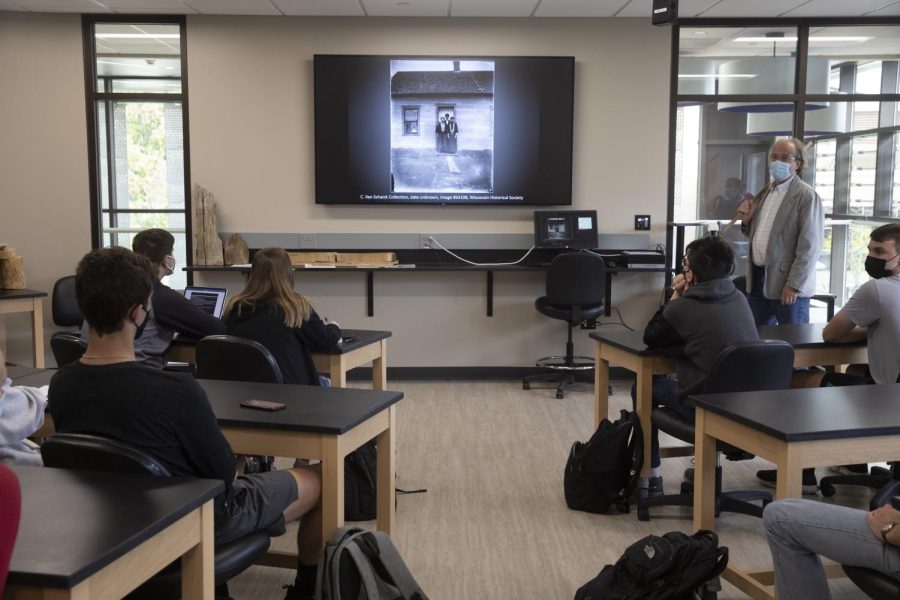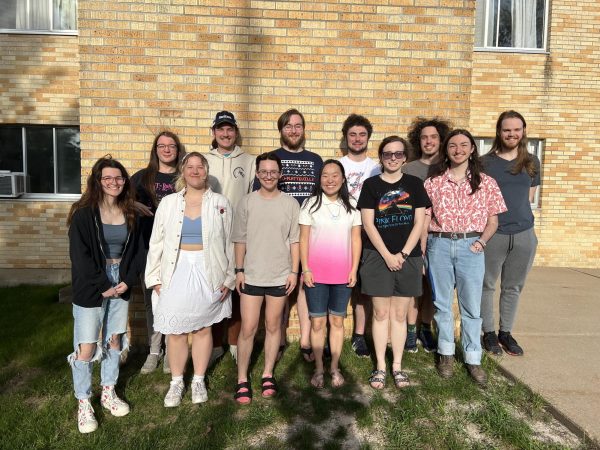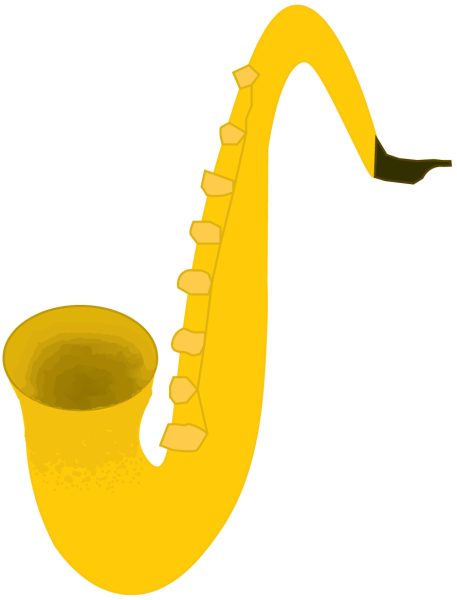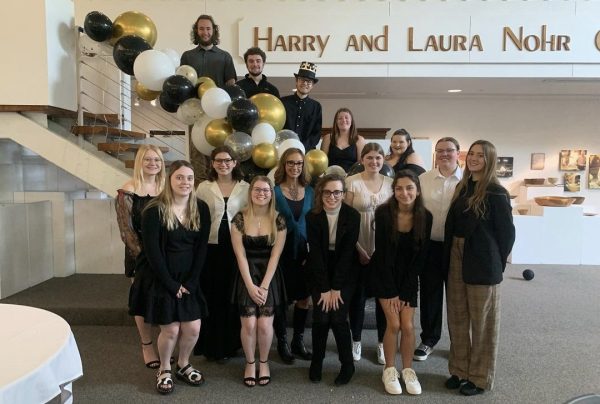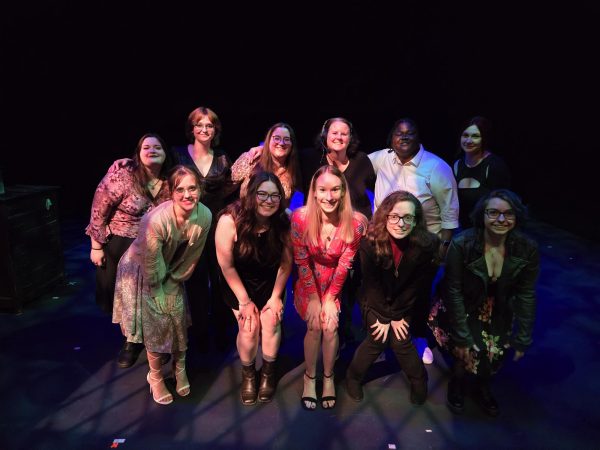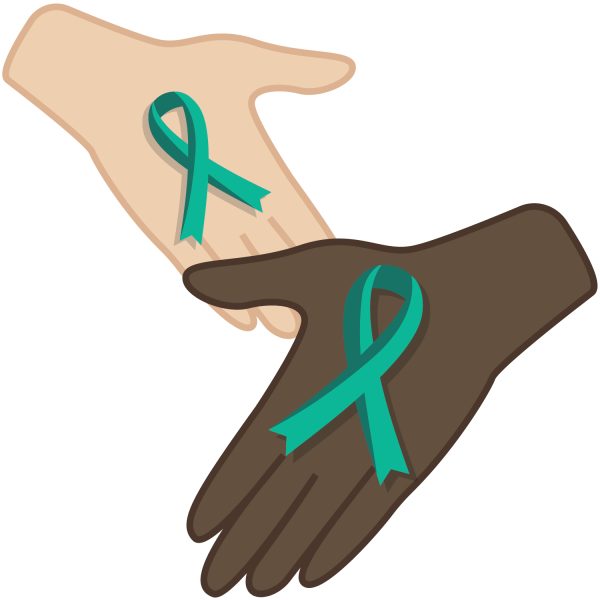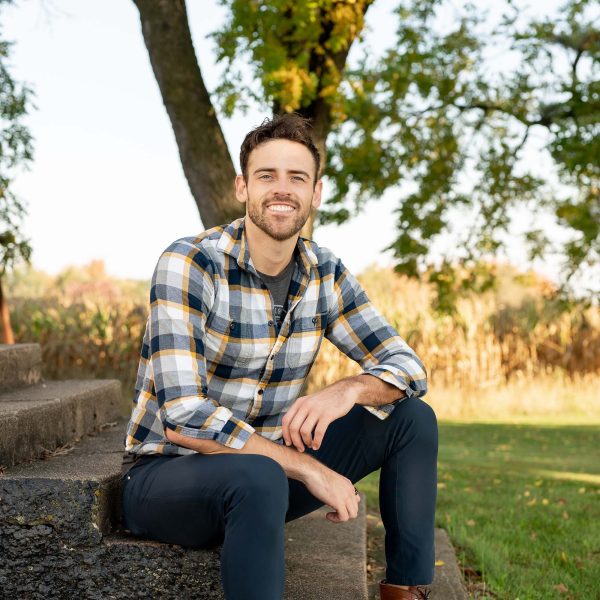Indigenous Peoples’ Day (Oct. 12)
Indigenous Landscapes: Expressions of Survivance
The second event of the IPD Celebration featured a presentation called “Indigenous Landscapes – Expressions of Survivance,” by Dr. John Broihahn, UW-Platteville 1974 alumnus and Wisconsin State Archaeologist Emeritus.
Dr. Broihahn presented research he conducted as a member of the State Archeology and Maritime Preservation Program at the Wisconsin Historical Society.
“I wanted to focus today on several late 19th to mid 20th century American Indian sites that we documented, Ojibwe communities, Ho-chunk and Potawatomi.”
Broihahn’s research focuses on recollecting an idea of the activities and involvement of Native American communities in areas that the mainstreamed historical timeline does not include.
“In the historical narrative, American Indian communities begin to disappear about the turn of the century,” Broihahn began. “When the French arrived in Wisconsin in the 1600s, Native Americans are part and parcel of all the stories, they continue to be mentioned on the regular basis when the British move into Wisconsin … and when the settlers first started to move into Wisconsin.
“But then, they sort of just disappear. The people don’t disappear, their communities don’t disappear, they’re still actively involved … but we just don’t hear a lot about them in the historical record.”
In order to represent these lost stories of the early, mid and late 1900s, Broihahn turned to the landscapes on which bands and communities lived.
By observing and analyzing previous sites of occupancies, Broihahn was able to create stories of survivance.
The concept of survivance was created and solidified by Gerald Vizenor, an Ojibwe author and scholar. Survivance, as defined by Vizenor, is in part “the active sense of presence, the continuance of native stories, not a mere reaction or a survival need.”
The sites that Broihahn used were expressions of exactly that: literal and proverbial footprints that indicated that Indigenous communities had lived not only to survive but also to thrive as lively cultural, social and economic groups amidst the changes on the North American continent around the 1900s.
To begin his in-depth review of the Indigenous sites, Broihahn included a timeline of Indigenous occupation reaching back 14,000 years.
“When the French arrived in Wisconsin in the 1600s,” Broihahn explained, “they stepped into a layered cultural landscape that had been created over thousands of years and consisted of extant community sites, resource use camps like berry camps, wild rice and maple sugar and honey camps, cemeteries, ceremonial sites, battlefields, spiritual places, and trails and travel routes.”
After giving sufficient background information, Broihahn dove into his research on four sites: Ho-Chunk homestead near Black River Falls, an off-reservation community site in Oneida County, a wild-ricing site in Vilas County and a Fond du Lac site in Wisconsin Point, near Superior and the border of Minnesota.
With help from descendant community members, local residents, and assistance from local, county and state government agencies, Broihahn collected information on the sites.
Broihahn began with the Ho-Chunk homestead site.
The U.S. government attempted to completely remove the Ho-Chunk people from Wisconsin. Never fully succeeding in their mission, the U.S. abandoned the effort after a short time. By then, though, significant numbers of people had been forced into adjacent states and areas.
The Ho-Chunk people were able to regain some of their territory by taking advantage of the Homestead Act in the late 1800s. It is believed that the Ho-Chunk people registered over 600 homesteads throughout the program’s history, but over time the land ownership had dwindled for legitimate and illegitimate reasons.
The Ho-Chunk homestead site near Black River Falls follows the homestead blueprint. Pictures from the early 1900s illustrate that these homesteads were built with frames made from wooden planks or logs covered in canvas.
Artifacts like galvanized pails, canning jars, metal cans for coffee, meat, and condiments, stoneware and fuel canisters, depict the survivance of the Ho-Chunk people. Photos from the early 1900s also provide evidence that Indigenous communities had tractors, cars and motorcycles to use in farming and transport.
Broihahn covered the off-reservation site and the wild-ricing site and finished with the Fond du Lac band site in Wisconsin Point.
“We did an archaeological survey out there at the request of Fond du Lac band members and we ended up finding about 170 or 175 cultural features. Some of them were standard, like cellars, pit features and berm foundations.”
Broihahn continued, “This is where we also ran into what we called cultural vegetation, where they would introduce plants like willow trees, lilies and irises and culturally modified trees that we think were used to collect birch bark and pine pitch.”
In the 1910s, the U.S. Steel Corporation decided to buy Wisconsin Point in order to construct a loading port. U.S. Steel completed a thorough survey of the land before displacing the Fond du Lac band.
This survey has been critical for modern archaeological projects. The survey documented a culturally important cemetery site, which had then been dug up and moved by U.S. Steel as part of construction efforts.
Broihahn added, “I can tell you from our experience at the Wisconsin Historical Society that no cemetery is completely removed.”
The Fond du Lac band dedicated a monument at the believed site of the cemetery to commemorate the injustice committed against them; the U.S. Steel Corporation never built the illustrious construction project for which they displaced the Fond du Lac.
Even with the original survey lost but with the approximate location of the monument, a land surveyor was able to pinpoint the location of cemetery as well as a few key features of culturally modified vegetation.
The research project in its entirety serves to prove that the Indigenous communities were not isolated and severed and, as Broihahn remarked, “They weren’t primitives living in the woods without knowledge of what’s going on around them.”
They participated in farming with machinery, in trading and commerce to the extent allowed by white society and customary to their traditions and established towns and wide networks on inter- and intracultural connections.
“Here’s my takeaway,” concluded Broihahn. “Physical evidence of survivance of previous and continuous Indigenous presence is preserved in Wisconsin … I think there are a lot of these sites out there and I think there’s a lot of interest in their communities to document them.”




